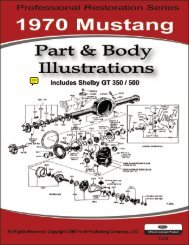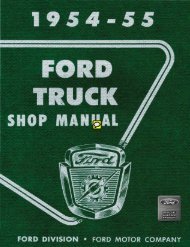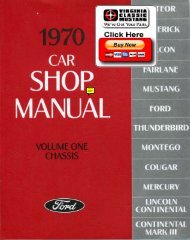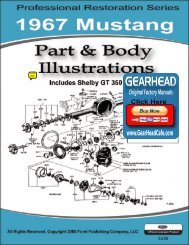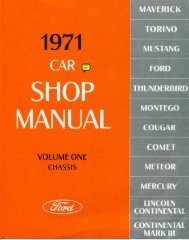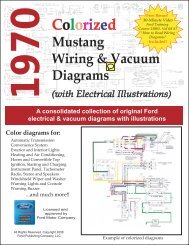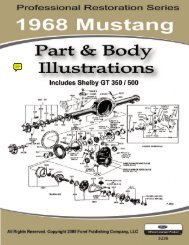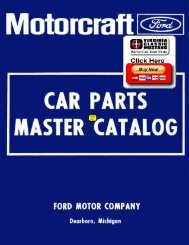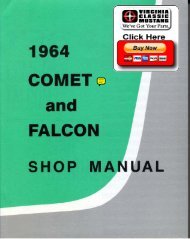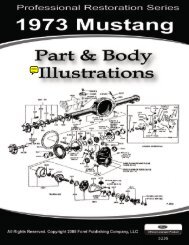DEMO - 1965 Ford Truck Shop Manual - ForelPublishing.com
DEMO - 1965 Ford Truck Shop Manual - ForelPublishing.com
DEMO - 1965 Ford Truck Shop Manual - ForelPublishing.com
Create successful ePaper yourself
Turn your PDF publications into a flip-book with our unique Google optimized e-Paper software.
PART 2-4 - VACUUM BOOSTERS 2-49<br />
snap ring and a new seal in the end<br />
plate.<br />
17. Screw the cylinder into the<br />
end plate, align the bleeder screw on<br />
the end cap with the bleeder screw<br />
on the end plate, then tighten the<br />
lock nut.<br />
18. Position a new copper washer<br />
in the end cap on the check nut and<br />
screw the hydraulic cylinder into the<br />
end cap. Tighten the cylinder securely.<br />
MIDLAND (DASH-MOUNTED)<br />
BOOSTER, DIAPHRAGM-TYPE<br />
DISASSEMBLY<br />
1. Remove the air filter cover, air<br />
filter, and retainer assembly from<br />
the booster body (Fig. 23).<br />
2. Remove the vacuum manifold<br />
and check valve assembly, and the<br />
rubber grommet from the booster<br />
body.<br />
3. Remove the rubber boot from<br />
the mounting bracket and valve operating<br />
rod.<br />
4. Remove the retaining nuts, and<br />
disassemble the mounting bracket<br />
from the booster end plate. Remove<br />
the gasket from the end plate.<br />
5. Remove the large C-ring that<br />
retains the rear seal adapter assembly<br />
to the booster end plate (Fig.<br />
23).<br />
6. Disengage the bellows from the<br />
booster body by pushing the bellows<br />
into the vacuum chamber (Fig. 24).<br />
7. Scribe a line across the booster<br />
body and end plate to facilitate<br />
proper alignment at assembly. Remove<br />
the bolt and nut from the<br />
clamp band, remove the clamp band,<br />
and separate the end plate from the<br />
booster body. Remove the diaphragm<br />
return spring.<br />
BOOSTER BODY<br />
H1266-A<br />
FIG. 25-Bellows Removal or<br />
Installation<br />
8. Separate the bellows, control<br />
valve, and diaphragm assembly from<br />
the end plate. Remove the O-ring<br />
that fits between the hub rear seal<br />
adapter assembly and the end plate<br />
(Fig. 23).<br />
9. Remove the large bellows retainer<br />
ring and the bellows assembly<br />
from the diaphragm and valve assembly<br />
(Fig. 25).<br />
10. Remove the retainer, support<br />
rings, bellows stay, and protector<br />
from the bellows (Fig. 23).<br />
CONTROL VALVE HUB<br />
REACTION LOAD RING<br />
PLUNGER GUIDES<br />
11. Remove the booster push rod<br />
assembly, the reaction lever and ring<br />
assembly, and the rubber reaction<br />
ring from the control valve hub<br />
(Fig. 26). Remove the two plastic<br />
plunger guides from the control<br />
valve plunger.<br />
12. Remove the retainer, the<br />
cushion ring, and the reaction cone<br />
from the booster push rod, then disassemble<br />
the levers from the reaction<br />
ring (Figs. 26 and 23).<br />
13. Remove the hub rear seal<br />
and adapter assembly from the rear<br />
of the control valve hub, then separate<br />
the hub and pluiiger assembly<br />
from the diaphragm. P.emove the retainer,<br />
the reaction load ring, the<br />
return spring, and the atmospheric<br />
valve from the hub and plunger,<br />
then slide the plunger out of the hub<br />
(Fig. 27). Remove the O-ring from<br />
the front side of the diaphragm. Remove<br />
the hub rear seal from the<br />
adapter assembly.<br />
14. Remove the O-rings and the<br />
"Block Vee" type seal from the<br />
valve plunger (Fig. 28).<br />
15. Do not remove the valve operating<br />
rod from the control valve<br />
plunger unless the plunger assembly<br />
or the rod is to be replaced. To remove,<br />
hold the rod firmly and force<br />
the plunger off the rod, breaking the<br />
plastic retainer. Remove all the<br />
broken pieces of the plastic retainer<br />
from the groove in the plunger, if<br />
the plunger is to be used again with<br />
a replacement rod.<br />
ASSEMBLY<br />
1. If the valve operating rod was<br />
removed from the plunger, assemble<br />
a new plastic retainer to the end of<br />
the rod (Fig. 23). Insert the rod into<br />
the plunger so that the retainer engages<br />
the groove in the plunger.<br />
2. Install the "Block Vee" type<br />
seal and the O-rings on the valve<br />
plunger assembly (Fig. 28).<br />
3. Insert the control valve plunger<br />
into the control valve hub from<br />
the rear of the hub (Fig. 27).<br />
DIAPHRAGM ASSEMBLY<br />
RUBBER REACTION RING<br />
REACTION CONE<br />
PUSH ROD ASSEMBLY<br />
BELLOWS<br />
FIG. 24-Bellows-to-Booster<br />
Body Engagement<br />
H1265-A<br />
REACTION LEVER AND<br />
RING ASSEMBLY RETAINER H1267-A<br />
FIG. 26-Disassembly or Assembly-Reaction Components and<br />
Push Rod-to-Valve Hub




